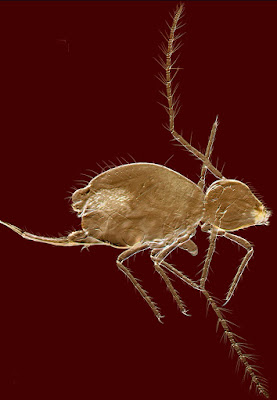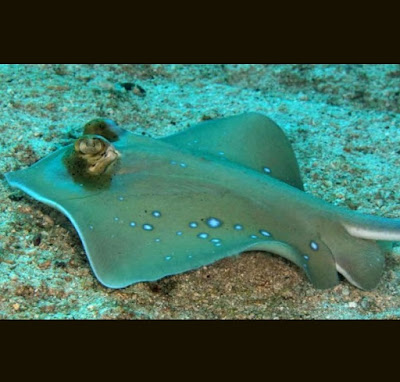![]() |
Species of Macrhybopsis aestivalis species complex from eastern North America. A) Macrhybopsis hyostoma, Female, 34 mm SL, Alabama, Limestone County, Elk River. B) Macrhybopsis boschungi, Female, 50 mm SL, Alabama, Dallas County, Cahaba River. C) Macrhybopsis etnieri, Female, 44 mm SL, Alabama, Bibb County, Cahaba River. D) Macrhybopsis pallida, Female, 36 mm SL, Alabama, Escambia County, Conecuh River. E) Macrhybopsis tomellerii, Female, 51 mm SL, Mississippi, Covington County, Pascagoula River drainage.
|
Abstract
For many years the North American cyprinid fish Macrhybopsis aestivalis (common name: Speckled Chub) was regarded as a single widespread and morphologically variable species, occurring in rivers throughout much of the Mississippi Valley and geographically adjacent eastern Gulf slope drainages, west to the Rio Grande basin in Texas, New Mexico, and Mexico. Eisenhour (1997) completed a morphological study of western populations of the Speckled Chub, the results of which appeared thereafter in published form (Eisenhour 1999, 2004). He demonstrated the existence of five valid species west of the Mississippi River (aestivalis, marconis, australis, tetranema, hyostoma), of which the name aestivalis was shown to be restricted to the population occurring in the Rio Grande and the geographically adjacent Rio San Fernando system, in northeastern Mexico. Eisenhour (2004) considered populations throughout the middle Mississippi Valley and its major tributaries to be a single morphologically variable species (hyostoma), and he also indicated that populations of Macrhybopsis from eastern Gulf slope drainages may represent a complex of species. Genetic confirmation of Eisenhour’s conclusions regarding western species appeared in the publication by Underwood et al. (2003), who also showed that western populations of M. hyostoma, as presently recognized, are genetically much more complex than previously considered.
Meanwhile, the present authors were involved in a companion study of eastern populations of Macrhybopsis, for which a genetic summary of the eastern Gulf coast species was published by Mayden & Powers (2004). Based on their findings, four species were recognized from southeastern drainages (identified as species A–D), although no formal taxonomic descriptions were included. Their genetic data, in combination with meristic, morphometric and other morphological data presented herein, form the basis for a revised classification of eastern Macrhybopsis populations, including formal descriptions of the four new species from eastern Gulf coast drainages.
Keywords: Pisces, Cyprinidae, Macrhybopsis, new species, eastern Gulf slope drainages, genetics, morphology, biogeography
![]() |
FIGURE 1. Species of Macrhybopsis aestivalis species complex from eastern North America.
A) Macrhybopsis hyostoma, UAIC 11060.03, Female, 34 mm SL, Alabama, Limestone County, Elk River, 28 September 1994. B) Macrhybopsis boschungi, UAIC 10845.03, Female, 50 mm SL, Alabama, Dallas County, Cahaba River, 12 July 1993. C) Macrhybopsis etnieri, UAIC 11053.01, Female, 44 mm SL, Alabama, Bibb County, Cahaba River, 24 June 1994. D) Macrhybopsis pallida, UAIC 10855.04, Female, 36 mm SL, Alabama, Escambia County, Conecuh River, 15 July 1993. E) Macrhybopsis tomellerii, UAIC 11364.03, Female, 51 mm SL, Mississippi, Covington County, Pascagoula River drainage, 18 February 1994. |
Systematic accounts
• Macrhybopsis hyostoma (Gilbert 1884)
Shoal Chub
Etymology. The species name hyostoma is derived from the words hyo (=hog) and stoma (=mouth), in reference to the underlying position of the mouth relative to the projecting snout.
• Macrhybopsis boschungi Gilbert & Mayden sp. nov.
Mobile Chub
Etymology. Named for the late Dr. Herbert T. Boschung, Emeritus Professor of Biology at the University of Alabama, for his many contributions over the years to southeastern ichthyology in general and the state of Alabama in particular, including co-authorship of Fishes of Alabama (Boschung & Mayden 2004).
It should be noted here that the vernacular name “Mobile Chub” used here differs from the name “Gulf Chub” applied by Boschung & Mayden (2004: 209; plate 21A). Considering its geographical distribution, we consider the former name to be more appropriate for the species.
• Macrhybopsis etnieri Gilbert & Mayden sp. nov.
Coosa Chub
Etymology. Named for Dr. David A. Etnier, Emeritus Professor of Zoology at the University of Tennessee, for his many contributions to southeastern ichthyology and aquatic biology, including co-authorship of the definitive book on the fishes of Tennessee.
![]() |
FIGURE 1. Species of Macrhybopsis aestivalis species complex from eastern North America.
A) Macrhybopsis hyostoma, UAIC 11060.03, Female, 34 mm SL, Alabama, Limestone County, Elk River, 28 September 1994. B) Macrhybopsis boschungi, UAIC 10845.03, Female, 50 mm SL, Alabama, Dallas County, Cahaba River, 12 July 1993. C) Macrhybopsis etnieri, UAIC 11053.01, Female, 44 mm SL, Alabama, Bibb County, Cahaba River, 24 June 1994. D) Macrhybopsis pallida, UAIC 10855.04, Female, 36 mm SL, Alabama, Escambia County, Conecuh River, 15 July 1993. E) Macrhybopsis tomellerii, UAIC 11364.03, Female, 51 mm SL, Mississippi, Covington County, Pascagoula River drainage, 18 February 1994. |
• Macrhybopsis pallida Gilbert & Mayden sp. nov.
Pallid Chub
Etymology. The species name pallida is in reference to the generally pallid body pigmentation characteristic of this species.
• Macrhybopsis tomellerii Gilbert & Mayden sp. nov.
Gulf Chub
Etymology. Named for Joseph R. Tomelleri, biological illustrator living in Leawood, Kansas, whose unsurpassed and meticulously rendered color illustrations of North American freshwater fishes have graced the pages of numerous scientific publications (including the present one), as well as books such as Fishes of the Central United States (Tomelleri & Eberle 1990) and Fishes of Alabama (Boschung & Mayden 2004).
C.R. Gilbert, R.L. Mayden and S.L. Powers. 2017. Morphological and Genetic Evolution in eastern Populations of the Macrhybopsis aestivalis complex (Cypriniformes: Cyprinidae), with the Descriptions of Four New Species.












































































